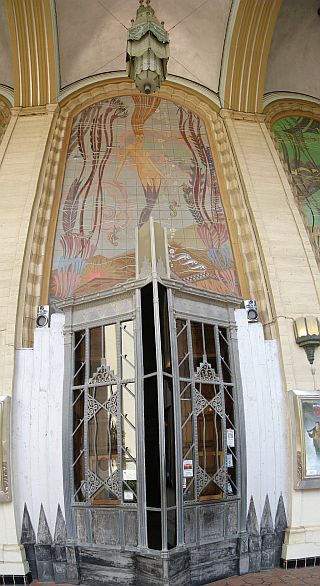 The Casino in Avalon, CA. on Catalina Island, is truly one of the world’s greatest Art Deco treasures. The mermaid over the box office (see a closer image here) has become an icon associated with Avalon – her image appears on event posters all over town and on the mainland in the terminals.
The Casino in Avalon, CA. on Catalina Island, is truly one of the world’s greatest Art Deco treasures. The mermaid over the box office (see a closer image here) has become an icon associated with Avalon – her image appears on event posters all over town and on the mainland in the terminals.
Cap’n Bob captured this vertical panorama of the mermaid while standing in the loggia at the entrance to the theater and ballroom. He combined three images to render this top-to-bottom view of the mural and box office. Click on her for the really big version – use the scroll bars to see the entire image.
More about the Casino’s murals from LAMurals.org:
Date
1929Location
The Casino’s Avalon Theatre
1 Casino Way
AvalonMedia Notes
Designed by John Gabriel Beckman. Executed by Emil Kosa. Jr., Aloyous Bohnen, Vyseled Ulianoff, Alexander Kiss, Eugene de Goncz.Description
Nine panels of underwater marine life including a mermaid encircle the loggia’s inside walls. They are painted directly on the concrete.Around the dome, within the auditorium in an Art Deco style, are local flora and fauna, scenes of early California, and abstract designs. They were painted on a burlap-like material with extra-fine ground pigments in a flatene medium (used as a binder by printers). On a seashell carried by seahorses, Venus rises from the the waves. She is the central figure above the proscenium arch. Inside the arch are other figures as well as a map of Catalina.
More about the Casino’s description and history from Away.com:
On Catalina, the biggest single attraction was the Casino, commissioned by chewing gum magnate William Wrigley, Jr., who had purchased the island in 1919. Never intended for gambling, Wrigley’s magnificent theater and ballroom were built to entertain the increasing number of tourists. Poised on Sugarloaf Point overlooking Avalon Bay, the Casino was a marvel of architecture of its time, the entrance and interior decorated with soaring, fantasy-like Art Deco murals of stylized Indians on horseback and aquatic creatures including a slithery mermaid.
The lower floor housed a motion picture theater with a “twinkle-light” ceiling to create a starry illusion. Far-sighted Wrigley, realizing “talkies” were on the way, had the theater designed with acoustics as good as many being built today. A huge Page organ provided the background music and sound effects for the “silents” that were the theater’s staple until the mid ’30s. Completely restored, today the organ is used for concerts. The theater, updated with Dolby sound, shows current movies.
The top-floor ballroom was the big drawing card, with music by greats of the Big Band era: Benny Goodman, Glen Miller, Freddy Martin, Little Jack Little, Dick Jurgens (sometimes accompanied by his glamorous wife, Dorothy Lamour), Bob Crosby, and the Bob Cats and Ray Nobel. The favorite and longest-playing band of all time was Jan Garber, whose smooth fox trots emanated from the Casino ballroom for four seasons, 1934-37, often drawing crowds of 5,000. Radio listeners looked forward to tuning in to the CBS network to hear the familiar voice of Don McBain announce, “From the beautiful Casino Ballroom, overlooking Avalon Bay at Catalina Island, we bring you the music of Kay Kyser,” or whatever band was scheduled. Island native Johnny W.R. Windle, 91, remembers his crew hauling every pound of material used in building the Casino when he was superintendent of transportation for the Santa Catalina Island Company. “It all came by barge from the mainland, then was trucked to the site. The night the Casino opened, 2,500 couples danced in the ballroom. Many were all dressed up, but it really didn’t matter. So long as you had a coat and tie, you could go in,” he recalls.
Dances are still held regularly in the ballroom, and the Casino stands almost unchanged as the island’s most identifiable landmark.
